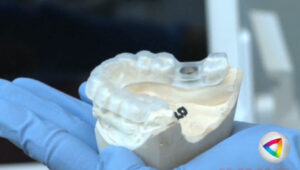
Root canals 101: What every patient should know
Does the following situation hit close to home?
All businesses are closed, you are working from home or relaxing with family. Out of nowhere, the worst throbbing pain starts inside your mouth. This could not happen at a worse time…
Sound familiar? You may need a root canal.
Has your dentist ever told you that you need a root canal? You are not alone. At Vitality Dentistry, root canals are used to save teeth. Millions of teeth are saved each year with root canals and will continue to be a very popular method of saving damaged teeth. This article will explain what root canals are and how they can save you from pain.
What is a root canal?
At Vitality Dentistry, we want you to know that root canals are one type of endodontic treatment. Let’s break it down:
“Endo”—Greek for “inside”
“Odont”—“Tooth”
The tooth is made up of three distinct layers: the outermost layer is the enamel, the part you can see. It is white and hard, almost porcelain-like. The second layer is the yellow dentin. It is soft and porous. There are small tubules going from the outmost to the innermost layer. Facing the innermost layer are the nerves and blood vessels, also known as the “pulp”. The pulp starts from the crown you can see inside your mouth all the way to the tip of the roots. The pulp of each tooth connects to a much larger set of nerves and blood vessels that help the tooth during development.
The pulp is very important during tooth development because it carries nutrients to the tooth. However, once the adult tooth has finished developing, the tooth does not need the pulp anymore to survive.
The tubules running throughout the second layer runs straight to the nerves. The tubes can act as a highway for many things including cold, hot, spicy, sweet and sour foods, cold air, and bacteria. When the tubules of dentin are exposed, these items can travel to the nerve causing a sharp pain. This is the characteristic “nerve pain” one might associate with teeth.
Tubules are exposed when you have lost the enamel, broken the tooth, worn down the tooth or have a cavity.
Stages of tooth pain:
- Reversible Pulpitis: When the nerve is exposed to irritants such as bacteria or a fracture, the tooth can enter a stage of reversible pulpitis. This is the reversible inflammation of the nerve. At this stage, it is important to see your dentist to prevent it from progressing.
Signs: pain to hot, cold or when something stimulates the tooth but not spontaneous pain. A root canal may not be needed at this time
- Irreversible pulpitis early stages: The nerve is “dying”.
Signs: Excruciating pain, pain to biting, hot, cold, pressure, may be swelling. May radiateto your jaw and different areas of your mouth. Note: at this stage, the pain will be generalised, and you may not know which tooth it is coming from. A root canal will be needed at this time.
- Irreversible pulpitis late stages. Signs: Excruciating pain and the same symptoms as Stage 2. The pain can now be pinpointed to one tooth.
- Necrosis: This stage may happen over years and may be associated with NO symptoms. There may be pain to pressure on the tooth or sometimes a swelling. The nerve has died and is rotting.
Do I need a root canal if it does not hurt?
A necrotic or dead tooth can lie dormant for years without any pain. This is because the nerve has degenerated. So why would you still need a root canal? In place of the nerve, bacteria and pus will lie inside your tooth leading to a chronic low-grade infection. This can spread to the supporting tooth structures and cause bone loss. The tooth can flare up at any time. It is not healthy to leave bacteria roaming around inside your mouth. Left untreated and you could have a massive abscess.
Why would you need a root canal?
When the pulp inside the tooth becomes infected and inflamed, a root canal may be needed. Inflammation and infection can be caused by decay, repeated procedures on a tooth and cracked teeth. If left untreated, severe pain or a throbbing abscess can result.
Do I need a root canal? What are the signs?
To summarize: prolonged pain to hot, cold, sometimes even breathing in cold air. Tender to touch, swollen lymph nodes, a bubble on the gum or a bad taste in your mouth. Sometimes, you may have no symptoms. Everyone has a different pain threshold.
Can all my teeth be saved with root canals?
Your dentists at Vitality Dentistry can restore many teeth with root canals but there are some conditions in which it cannot be saved. These include but are not limited to:
- Root is fractured
- Tooth is severely broken down
- Tooth is severely mobile or not enough bone
When traditional root canal therapy cannot be done, an endodontic surgery can be done to save the tooth or the tooth can be taken out.
What does a root canal feel like?
The tooth is likely inflamed so Dr. Singh and Dr. Leigh at Vitality Dentistry will be very careful to give you additional freezing before starting the procedure. After that, you will feel very little. The dentist will remove the inflamed and infected pulp, and carefully clean the inside of the tooth, filling and sealing the space with a sterile material.
Can I go to work after?
Absolutely! Root canal procedures are completed to relieve toothaches. Modern techniques and solutions of anaesthetic are used, and most patients feel no pain during the procedure.
For the next few days, your tooth may have some mild tenderness which can be resolved with over the counter pain relievers.
Dr. Singh and Dr. Leigh listen to all of your dental concerns and will make the experience of having a root canal convenient and easy.






